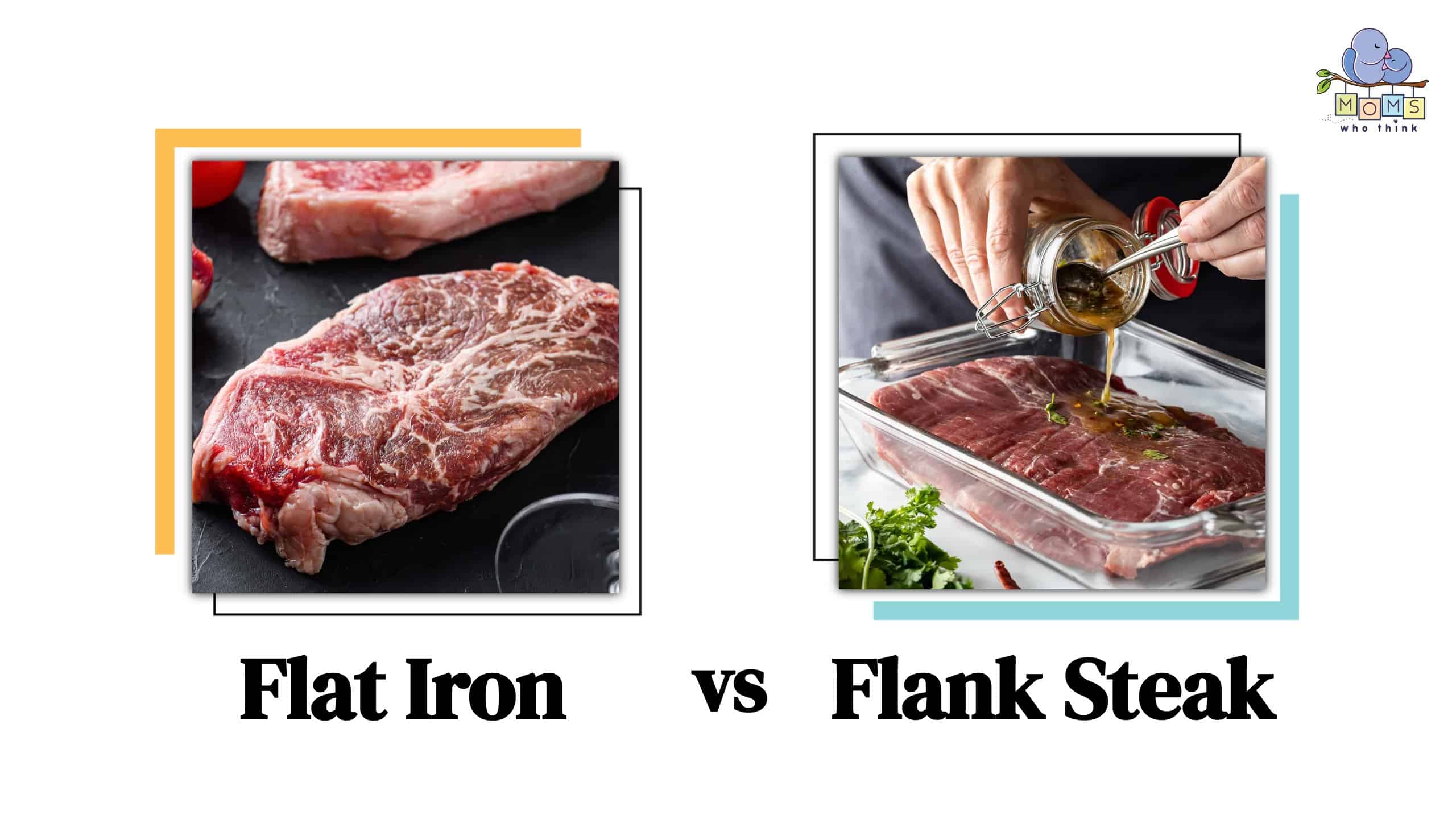When selecting the perfect cut of beef, flat iron and flank steak are two popular choices that have captured many people's taste buds. Although both originate from cows, they differ in origin, flavor, and cooking methods. In this article, we will look at these two cuts of meat in more detail, exploring their distinct characteristics and giving tips on preparing them for a delicious meal. First, let's explore the world of flat iron and flank steak and discover how to make the most of these delicious cuts of meat.
The Primary Differences Separating Flat Iron vs Flank Steak
The primary difference between flat iron and flank steak is that flat iron is more flavorful and less tough than flank steak. The flat iron steak comes from the cow's shoulder and has marbling, while the flank steak comes from the cow's abdominal muscles and is leaner. Many ways exist to cook these steaks, and they offer different tastes. For example, flank steak is often marinated to make it more tender.
Cut Differences
Flat iron steak and flank steak come from different parts of the cow. The chuck primal is the commonly known shoulder part of the cow, where the flat iron steak originates. The flank steak comes from the cow's abdominal area, known as the primal flank.
The primal flank cut contains several muscles throughout the meat, so marinating is necessary to tenderize it, just like the chuck primal. It's essential to cook the meat carefully to avoid making the flank primal or flank steak tougher.
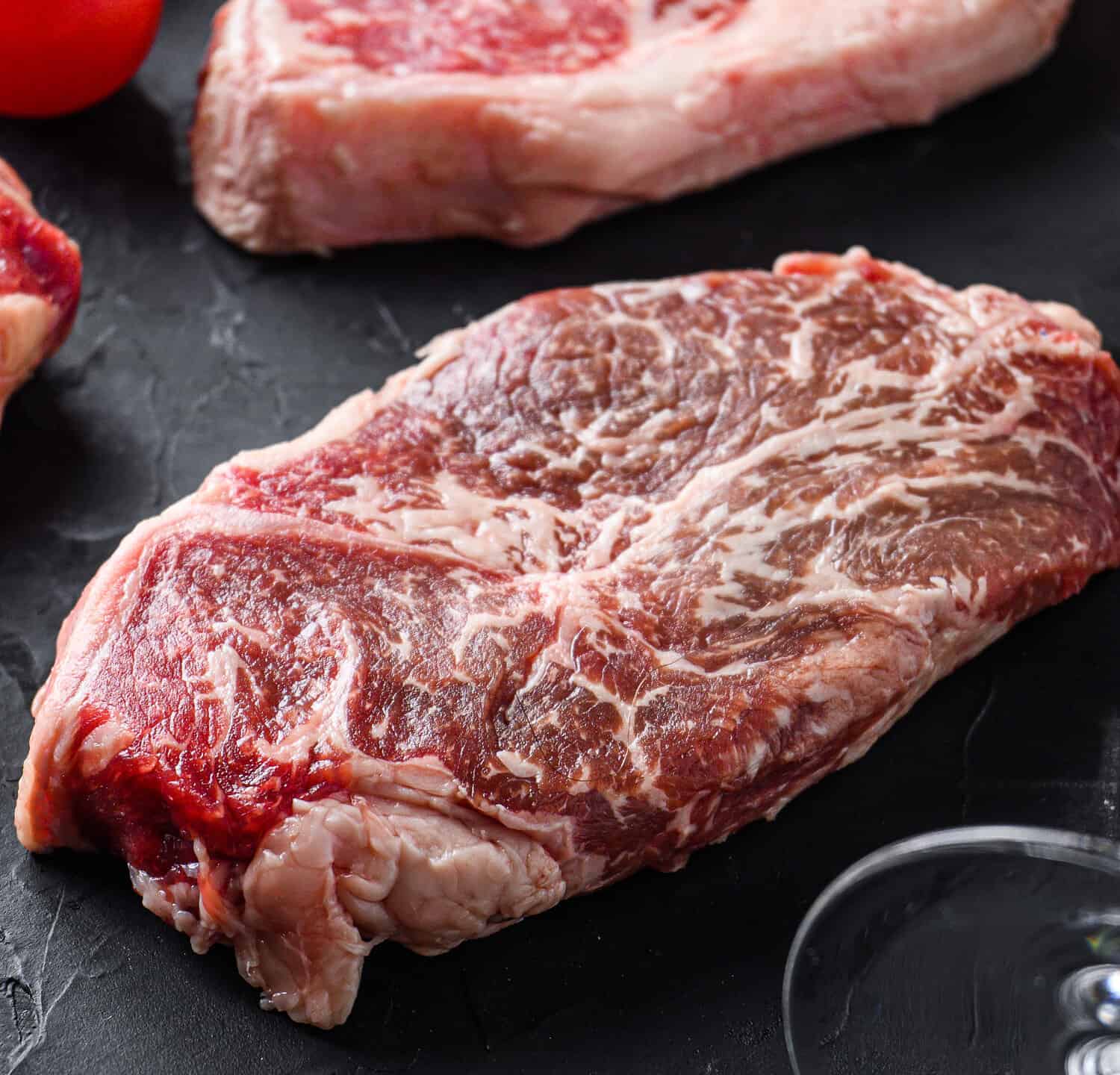
Flat iron steak is a tender, flavorful cut from the shoulder of a cow.
©Chatham172/Shutterstock.com
Taste Differences
The high marbling content in flat iron steak results in highly flavorful meat. Because it is a leaner cut of meat, flank steak has less flavor than flat iron steak. However, it still has a robust beefy flavor because of the well-exercised muscle in the meat.
Cooking Method Differences
Grilling or pan frying are the recommended methods for cooking flat iron steak. It is important to avoid overcooking the steak. For the best results, cook this cut of meat to a medium-rare to medium level of cooking. It would be best if you cooked flank steak on a high-heat grill or frying pan for the best results. For ideal taste, serve it medium rare. Additionally, it is versatile and can get used in various recipes.
Flat Iron Steak
People know the flat iron steak as a type of beef that they also call top-blade steak, shoulder-top blade steak, or top-blade filet. The marbling in the meat provides the steak's moisture and tenderness. You can prepare this steak in various ways, including grilling, broiling, or pan-searing, making it a versatile option for cooking. In addition, this option is affordable for individuals who want to enjoy a tasty steak without exceeding their budget.
The connective tissue is removed to separate the top blade roast into two cuts of meat. This results in the formation of the flat iron steak and the top blade steak. The flat iron steak earns its name from its resemblance to an old-fashioned metal flat iron, being a thick rectangular cut of beef.
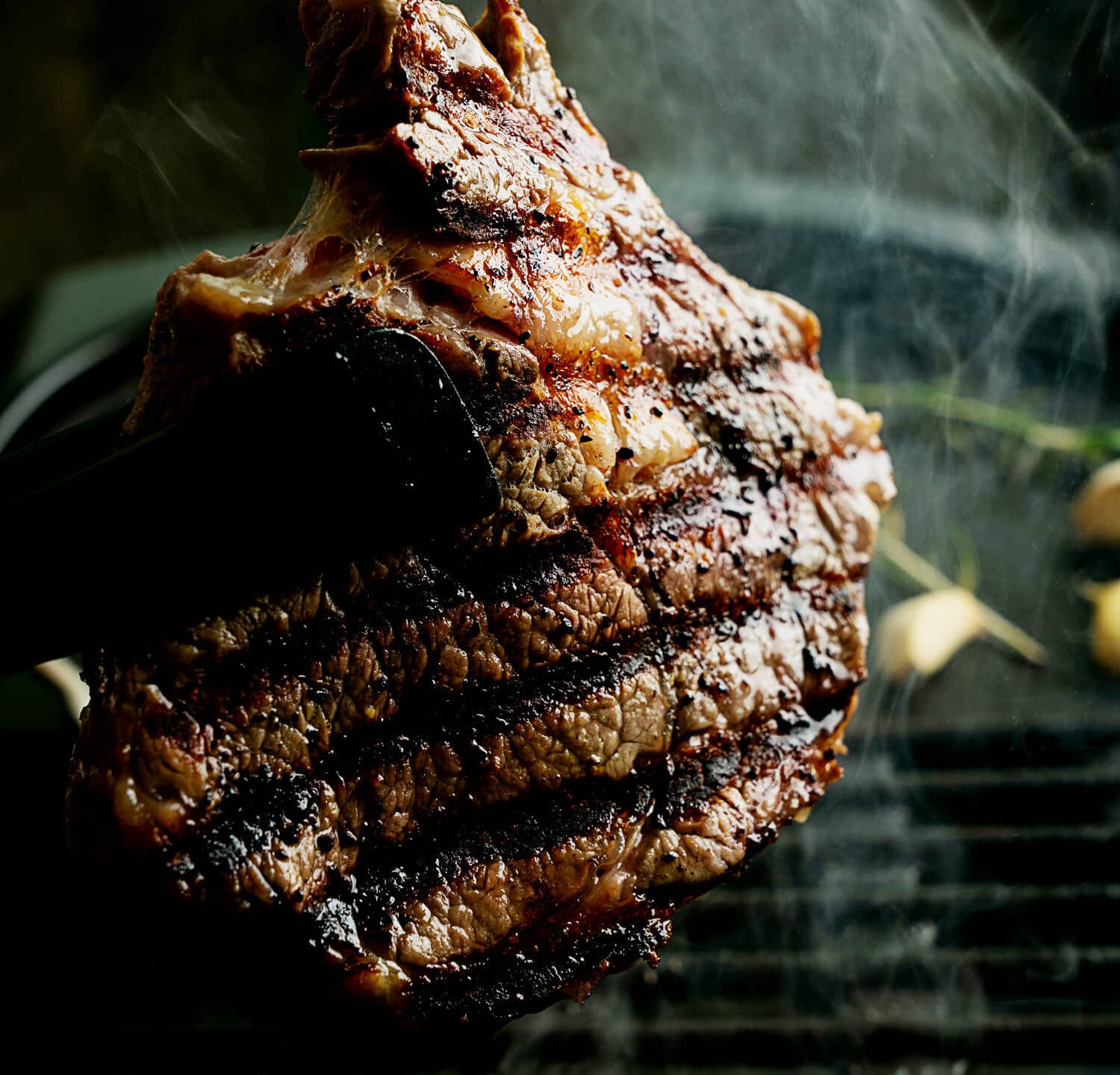
A great way to cook flat iron steak or flank steak is on the grill.
©Pedal to the Stock/Shutterstock.com
Nutritional Value
Flat iron steak, a healthy meat cut, offers numerous nutritional benefits that can greatly enhance your health. This cut of steak has a high amount of zinc and vitamin B12, high protein, and no carbohydrates. The following chart is based on a 3.5-ounce serving of flat iron steak.
| Nutrition | Portion size: 3.5 oz |
|---|---|
| Calories | 137 g |
| Total fat | 6 g |
| Saturated fat | 2.7 g |
| Cholesterol | 71 mg |
| Sodium | 86 mg |
| Carbohydrates | 0 g |
| Protein | 20 g |
| Zinc | 7.45 mg |
Cooking Methods
Flat iron steak is tasty and versatile and can be cooked in many ways. Some different ways to cook a flat iron steak are reverse searing, sous vide, grilling, or pan searing. Prepared correctly, this type of meat can come out tender and juicy, perfect for any occasion.
- Reverse searing: Season the steak with kosher salt and leave it in the fridge overnight. Bring the steak to room temperature, pat the steak dry, then place the steak in the oven until the meat is medium rare to medium.
- Sous vide: Season the steak with kosher salt and leave it in the fridge overnight. Preheat sous vide to 129 degrees Fahrenheit, season the steak to your liking, and place the steak in a vacuum-sealed bag, put the bag in the water and cook it for 2 hours. Sear the steak on each side to create a crispy exterior.
- Grilling: Season the flat iron steak with kosher salt and leave it in the fridge overnight. Bring the steak to room temperature, heat the grill, spray the steak with olive oil on each side, and grill until medium-rare to medium.
Flank Steak
Flank steak is a meat cut from the lower chest or the abdominal muscle. It is an affordable cut of beef that is versatile and flavorful. The flank steak is called bavette, jiffy steak, and London broil. You can identify this cut of meat by the direction of the meat's cross-grain.
This cut of steak lacks marbling but has a robust meaty flavor. Because of the smaller amount of marbling, this steak is tougher than some other cuts, but cooking it to medium rare will keep the juicy interior and provide tenderness in the meat. It is a chewy piece of meat, but slicing it thinly across the grain will reduce the chew in the steak.
Nutritional Profile
Flank steak has many calories, vitamins, minerals, proteins, and fats. It is a very nutritious cut of meat that can benefit your health in many ways. Below is a chart that shows the nutritional value of an average 3-ounce serving.
| Nutrition | Portion size: 3 oz |
|---|---|
| Calories | 162 g |
| Protein | 24 g |
| Total fat | 6 g |
| Saturated fat | 3 g |
| Monosaturated fat | 3 g |
| Carbohydrates | 0 g |
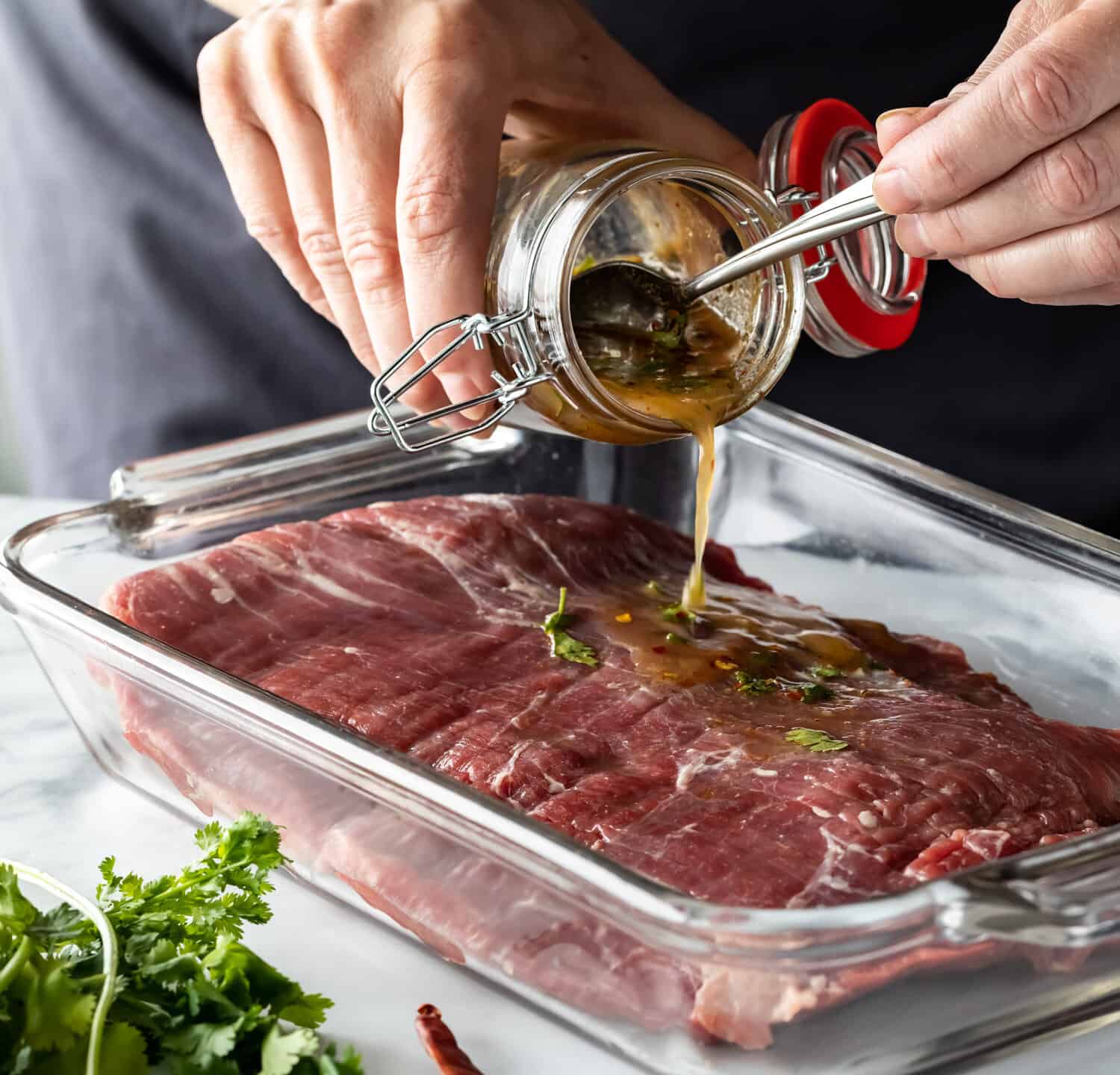
Marinating flank steak will make it juicy and tender.
©Toasted Pictures/Shutterstock.com
Cooking Methods
Cooking flank steak is easy. You will only need a few ingredients, and it only takes around 20 minutes to cook a medium-rare steak. You can cook the flank steak in many ways, but the best three ways are grilling, pan frying, or reverse searing.
- Grilling: Season your steak to your liking and let it rest for an hour. Prepare the grill, cut through the connective tissue running through the steak, then grill the steak for 6 to 8 minutes.
- Pan frying: Bring the steak to room temperature, season to liking, cut through the connective tissue, preheat the pan to its highest heat, pour olive oil into the pan, and cook the steak for 2 minutes on each side, halfway through cooking you should add butter and fresh herbs to the pan, cook the steak until it reached a medium-rare level of doneness.
- Reverse searing: Bring steak to room temperature, preheat the oven to 275 degrees Fahrenheit, cut through the connective tissue, place the steak on a baking sheet and cook the steak for 15 minutes to achieve a medium rare steak. Next, preheat a pan and sear the steak on each side to give it a crispy exterior.
Steak Recipes
Conclusion
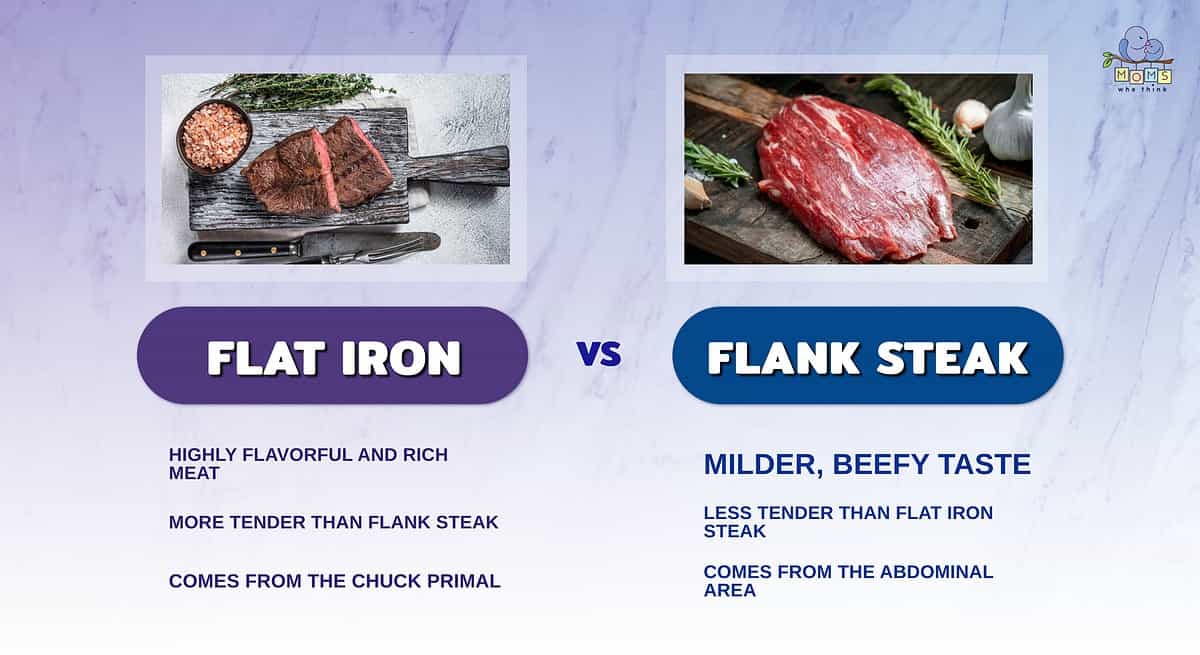
- A flat iron steak is extremely flavorful and rich, contrasting the milder and beefier taste of a flank steak.
- Flank steak is known as one of the tougher cuts of beef, while flat iron is quite tender. Flank steak usually requires a marinade to get sufficiently tender.
- The flat iron cut comes from the chuck primal, which is in the shoulder of the cow. Meanwhile, flank steak comes from the abdominal area of the cow, known as the primal flank.

Spinach-Stuffed Flank Steak
- Yield: 4
Ingredients
- 1/4 cup of dried tomatoes (not oil-packed)
- 1 1-pound of beef flank steak or top round steak (trimmed of separable fat)
- 1/8 teaspoon salt
- 1/8 teaspoon black pepper
- 1 10–ounce package of frozen chopped spinach, thawed and well drained
- 2 tablespoons grated parmesan cheese
- 2 tablespoons of snipped fresh basil
Instructions
- In a small bowl soak the dried tomatoes in enough hot water to cover for 10 minutes. Drain and snip into small pieces.
- Meanwhile, score both sides of steak in a diamond pattern by making shallow diagonal cuts at 1-inch intervals.
- Place meat between 2 pieces of plastic wrap. Working from center to edges, pound with the flat side of a meat mallet into a 12×8-inch rectangle. Remove plastic wrap.
- Sprinkle with the salt and pepper.
- Spread the spinach over the steak. Sprinkle the softened tomatoes, parmesan cheese, and basil.
- Roll the steak up from a short side. Secure with wooden toothpicks at 1-inch intervals, starting ½ inch from an end. Cut between the toothpicks into eight 1-inch slices.
- Place sides cut side down on the unheated rack of a broiler pan. Broil 3 to 4 inches from the heat until done as desired, turning once.
- Allow 10 to 12 minutes for medium rare (145°F) or 12 to 16 minutes for medium (160°).
- Before serving, remove toothpicks.
Nutrition
- Serving Size: 2 slices
- Calories: 214
- Sodium: 348mg
- Fat: 9g
- Saturated Fat: 4g
- Carbohydrates: 4g
- Fiber: 2g
- Protein: 28g
- Cholesterol: 47mg
Both flat iron and flank steak have unique flavors and textures, making them ideal for various dishes. You can create tasty dishes highlighting each cut's best qualities by knowing their differences in origin, taste, and cooking techniques. Additionally, whether you prefer the tenderness and marbling of flat iron steak or the robust, beefy flavor of flank steak, understanding how to cook and serve these cuts will boost your culinary skills and satisfy your taste buds.
